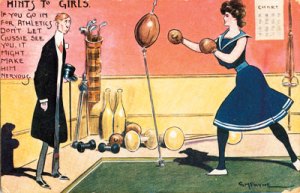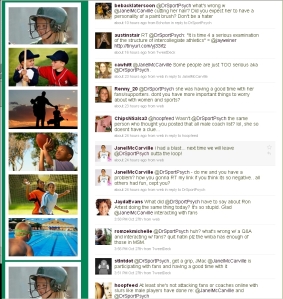Yesterday I was invited to be part of a panel for the inaugural Minnesota Lynx Girls and Women in Sport Career Day (kudos to Carly Knox and her Lynx colleagues for putting on this event!)
Myself and 5 other women in the Twin Cities area spoke about our experiences, career pathway, advice for being successful in a male dominated profession and “a-ha!” moments in our careers. On the panel with me: Cheryl Reeve, Head coach MN Lynx; Laura Day; VP of Business Development for the Twins; Britt Carlson, Director of Premium Seating at Minnesota Timberwolves & Target Center; Rachel Blount, StarTribune Sports Columnist; and rookie Lynx player Monica Wright.
I didn’t know what to expect but I learned a great deal from these accomplished women! There were many common themes, which I found fascinating because we wrote our comments independently. Here are some take homes and some reflections I’ve had since last night:
1. NETWORK!!! Get your foot in the door any way you can, and when you get the opportunity make the most of it. You only get one chance to make a first impression, so be ready and remember you are always interviewing for a job. Dress for the job you want, not the job you have. Seek out mentors and surround yourself with good people. I loved when Monica Wright told the audience, “Be loud and confident, and project yourself well”…which she was modeling!
2. Follow your passion. Don’t let anyone or anything stand in the way of your passion and goals. One young woman in the audience asked Coach Reeve if she thought more women would begin to coach men. I wanted to tell this young woman that statistically speaking her chances were very low, but on second thought…good for her! We need more females thinking coaching males is a viable career pathway and to strive to make inroads. If a young man had asked about coaching women, no one would of batted an eyelash. You Go Girl!….coach those males, and pursue your passion. Rachel Blount told a story about how a college football coach once told her to “go back to baking biscuits” rather than try to interview one of his players. She told me that not once in her 25 years as a sport reporter did she think of not doing what she loved, “I was born to do this!” she claimed emphatically….and I agree!
 What was really interesting to me is that we were all asked to talk about our experiences in a male dominated profession. Only myself and Rachel Blount talked explicitly about sexism and how females are statistically the token minority in all sports careers. The other women said they’d never experienced sexism or any male-created obstacles–or perhaps didn’t want to talk about it if they had. I was really surprised by their admissions especially because I had I just ordered two books I cannot wait to read on this subject–Sexism in America: Alive, Well and Ruining Our Future (Berg, 2009), and Enlightened Sexism: The Seductive Message That Feminism’s Work is Done (Douglas, 2010). I think both books will help me reflect on these women’s claims of a lack of experienced sexism. I came upon these books when I found a new blog this week titled Equality Myth: Young Women, Sexism, and the Workplace which got me thinking about how these concepts apply to my work with female coaches.
What was really interesting to me is that we were all asked to talk about our experiences in a male dominated profession. Only myself and Rachel Blount talked explicitly about sexism and how females are statistically the token minority in all sports careers. The other women said they’d never experienced sexism or any male-created obstacles–or perhaps didn’t want to talk about it if they had. I was really surprised by their admissions especially because I had I just ordered two books I cannot wait to read on this subject–Sexism in America: Alive, Well and Ruining Our Future (Berg, 2009), and Enlightened Sexism: The Seductive Message That Feminism’s Work is Done (Douglas, 2010). I think both books will help me reflect on these women’s claims of a lack of experienced sexism. I came upon these books when I found a new blog this week titled Equality Myth: Young Women, Sexism, and the Workplace which got me thinking about how these concepts apply to my work with female coaches.
One young woman asked the panel why none of us mentioned children and how having kids influenced our careers. All of us looked at each other and a silent awkward pause ensued….none of us had children! Was it coincidental that all 5 women (I’ll exclude Monica Wright, because she isn’t in the same place in her career as the rest of us) were successful yet had no children? I immediately had a sick feeling. What did this mean? What message did it send to the young women in the audience who wanted both a career and children?
I quickly thought of Arlie Hochschild’s work on “the second shift”, which still unfortunately still holds true for a majority of women. The second shift for working women, is the idea a “second shift” or job starts when she comes home and is largely responsible for domestic and child-rearing duties. From the work I’ve done with female coaches, many of them discuss how coaching is only possible for them because their husbands also coach and that is “just what our family does”. My message to the audience was–if you want to have a family and career (which is possible!), be sure to choose a partner that will be supportive of your passion and is willing to be equally involved in child care and domestic duties. One problem in this model is that on average women still make 77 cents to every $1 made by men, so having 2 working parents isn’t always the best financial choice if the cost of child care, outweighs the second income (here is fact sheet written by the Institute for Women’s Policy Research on the gender pay gap). So which income goes? The one who earns the least…which is usually the female (if the couple is male-female).
I have a lot more thinking to do about these topics and what it means for my career, my research and teaching, and for the next generation of young women. The event was very empowering and energizing, but the reflections I’ve had since the event have been admittedly depressing. I like action items that lead to social change, but when the actions required are tackling gender stereotypes, male power, and work/family gender roles…it seems daunting! But I will take my own advice and not let anything get in the way of pursuing my passion, which is trying to make a difference in the lives of females in and through sport.
What are your thoughts?










